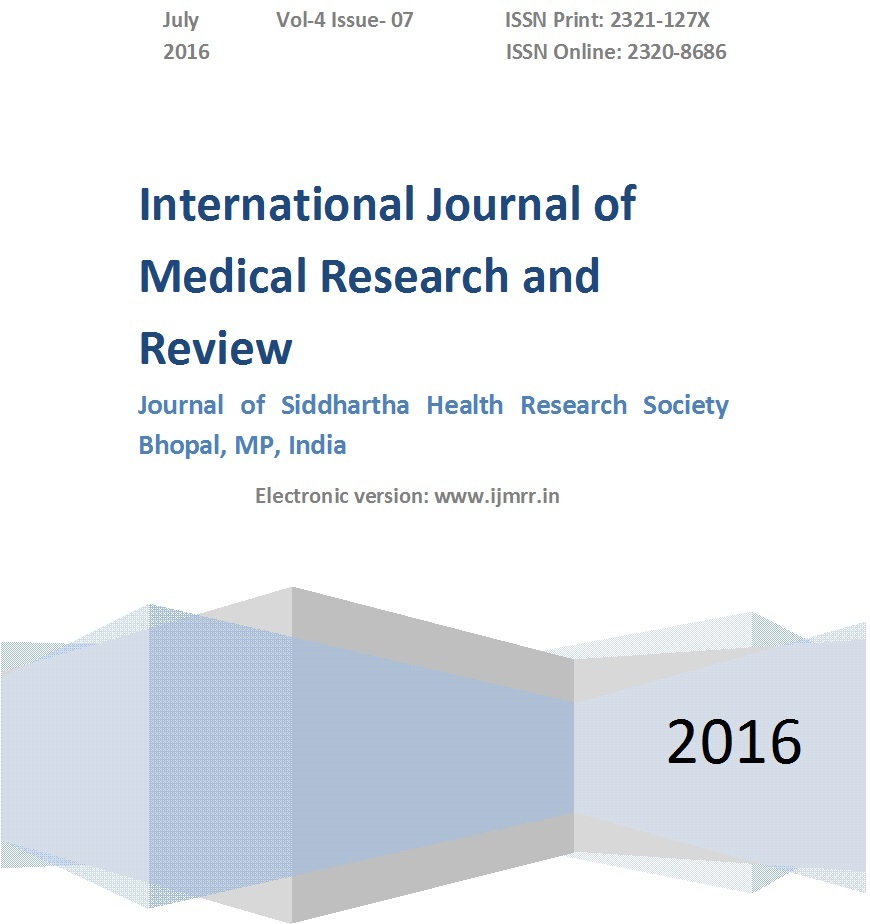Knee arthroscopy postoperative analgesia by multimodal cocktail regime
Abstract
Background: Post-operative knee pain management have become a challenge to provide early relief and pain free postoperative care to the patient. Adequate analgesia influences the early rehabilitation of the patient and hospital stay.Many factors have been implicated to influence post arthroscopy pain such anesthetic technique, residual effects of perioperative analgesia, patient pain threshold, preoperative pain level, the use and duration of tourniquet exsanguination, surgical trauma involved, volume of drug injected, the experience of the surgeons, the sex of the patient and the postoperative activity level of the patients.The purpose of this study is to assess the efficacy of the multidrug regime for management of postoperative pain during first 24 hours.
Methods: In our study 57 patients of both the sexes were evaluated for postoperative pain following various elective arthroscopic knee surgeries such as ligament reconstruction, cartilage procedures and diagnostic arthroscopic procedures. Patients were evaluated for pain using visual analogue score at 6th hour,12th hour and 24 hours’ post-operative. A cocktail prepared of multidrug was used for the study.
Results: The new cocktail regime provides adequate analgesia with no patients requiring additional analgesia for first 12 hours and only 2 patients whose VAS [visual analogue scale] was greater than 4 required additional analgesia at the end of 24 hours postoperative.
Conclusion: Multi drug cocktail regime provides a good analgesic for post-operative knee arthroscopic surgery without the need of rescue analgesics. Intra articular local analgesia reduces overall use of parenteral analgesics and also helps in quicker rehabilitation.
Downloads
References
Dye SF, Vaupel GL, Dye CC. Conscious neurosensory mapping of the internal structures of the human knee without intraarticular anesthesia. Am J Sports Med. 1998 Nov-Dec;26(6):773-7.doi: https://doi.org/10.1177/03635465980260060601.
Henderson RC, Campion ER, DeMasi RA, Taft TN. Postarthroscopy analgesia with bupivacaine. A prospective, randomized, blinded evaluation.Am J Sports Med. 1990 Nov-Dec;18(6):614-7.doi: https://doi.org/10.1177%2F036354659001800610.
Laurent SC, Nolan JP, Pozo JL, Jones CJ. Addition of morphine to intra-articular bupivacaine does not improve analgesia after day-case arthroscopy.Br J Anaesth. 1994 Feb;72(2):170-3.doi: https://doi.org/10.1093/bja/72.2.170.
Johnson DS, Stewart H, Hirst P, Harper NJ. Is tourniquet use necessary for knee arthroscopy?Arthroscopy. 2000 Sep;16(6):648-51.doi: https://doi.org/10.1053/jars.2000.4826.
Kirkley A, Rampersaud R, Griffin S, Amendola A, Litchfield R, Fowler P. Tourniquet versus no tourniquet use in routine knee arthroscopy : A prospective ,double blind , randomised clinical trial. Arthroscopy .2000;16(2):121-6.doi: https://doi.org/10.1016/s0749-8063(00)90024-0.
Rosseland LA, Stubhaug A, Skoglund A, Breivik H. Intra-articular morphine for pain relief after knee arthroscopy.ActaAnaesthesiol Scand. 1999 Mar;43(3):252-7.doi: https://doi.org/10.1034/j.1399-6576.1999.430303.x.
Rosseland LA, Stubhaug A. Gender is a confounding factor in pain trials: women report more pain than men after arthroscopic surgery.Pain. 2004 Dec;112(3):248-53.doi: https://doi.org/10.1016/j.pain.2004.08.028.
Whitford A, Healy M, Joshi GP, McCarroll SM, O'Brein TM. The effect of tourniquet release time on the analgesic efficacy of intraarticular morphine after arthroscopic knee surgery. Anesthesia and Analgesia.1997;84(4):791-3.doi: https://doi.org/10.1097/00000539-199704000-00017.
Chapman CR, Casey KL, Dubner R, Foley KM, Gracely RH, Reading AE. Pain measurement: an overview.Pain. 1985 May;22(1):1-31.doi: https://doi.org/10.1016/0304-3959(85)90145-9.
Kaeding CC, Hill JA, Katz J, Benson L. Bupivacaine use after knee arthroscopy: pharmacokinetics and pain control study.Arthroscopy. 1990;6(1):33-9.doi: https://doi.org/10.1016/0749-8063(90)90094-t.
Emmanuel Marret, Marc Gentili, Marie Pierre Bonnet, Francis Bonnet. Intra-articular ropivacaine 0.75% and bupivacaine 0.50% for analgesia after arthroscopic knee surgery: A randomized prospective study. Presented at the Euroanaesthesia meeting, Glasgow, Scotland, May 2003.DOI: http://dx.doi.org/10.1016/j.arthro.2004.11.005
Koppert W, Ostermeier N, Sittl R, Weidner C, Schmelz M. Low-dose lidocaine reduces secondary hyperalgesia by a central mode of action.Pain. 2000 Mar;85(1-2):217-24.doi: https://doi.org/10.1016/s0304-3959(99)00268-7.
Hollmann MW, Durieux ME. Local anesthetics and the inflammatory response: a new therapeutic indication?Anesthesiology. 2000 Sep;93(3):858-75.doi: https://doi.org/10.1097/00000542-200009000-00038.
MacGregor RR. The effect of anti-inflammatory agents and inflammation on granulocyte adherence. Evidence for regulation by plasma factors.Am J Med. 1976 Nov;61(5):597-607.doi: https://doi.org/10.1016/0002-9343(76)90137-6.
Mac Gregor RR, ThornerRE , Wright DM. Lidocaine inhibits granulocyte adherence and prevents granulocyte delivery to inflammatory sites.Blood.1980;56(2):203-9.
Piper SL, Kramer JD, Kim HT, Feeley BT. Effects of local anesthetics on articular cartilage.Am J Sports Med. 2011 Oct;39(10):2245-53. doi: https://doi.org/10.1177%2F0363546511402780. Epub 2011 Apr 22.
Ravnihar K, Barlič A, Drobnič M. Effect of intra-articular local anesthesia on articular cartilage in the knee.Arthroscopy. 2014 May;30(5):607-12. doi: https://doi.org/10.1016/j.arthro.2014.02.002.
Reuben SS, Connelly NR. Postoperative analgesia for outpatient arthroscopic knee sugery with intraarticular bupivacaine and ketorolac.AnesthAnalg. 1995 Jun;80(6):1154-7.doi: https://doi.org/10.1097/00000539-199506000-00015.
Butterworth JF 5th, Strichartz GR. The alpha 2-adrenergic agonists clonidine and guanfacine produce tonic and phasic block of conduction in rat sciatic nerve fibers.AnesthAnalg. 1993 Feb;76(2):295-301.
Stein C, Comisel K, Haimerl E, Yassouridis A, Lehrberger K, Herz A, Peter K. Analgesic effect of intraarticular morphine after arthroscopic knee surgery.N Engl J Med. 1991 Oct 17;325(16):1123-6.doi: https://doi.org/10.1056/nejm199110173251602.
Kalso E, Tramèr MR, Carroll D, McQuay HJ, Moore RA. Pain relief from intra-articular morphine after knee surgery: a qualitative systematic review.Pain. 1997 Jun;71(2):127-34.doi: https://doi.org/10.1016/s0304-3959(97)03344-7.
Stein C, Schafer M, Cabot PJ,etal. Peripheral opiodanalgesia. Pain Rev 1997;4:173-87.
Stein C, Comisel K, Haimerl E, Yassouridis A, Lehrberger K, Herz A, Peter K. Analgesic effect of intraarticular morphine after arthroscopic knee surgery.N Engl J Med. 1991 Oct 17;325(16):1123-6.
Joshi GP, McCarroll SM, Cooney CM, Blunnie WP, O'Brien TM, Lawrence AJ. Intra-articular morphine for pain relief after knee arthroscopy.J Bone Joint Surg Br. 1992 Sep;74(5):749-51.
Khoury GF, Chen AC, Garland DE, Stein C. Intraarticular morphine, bupivacaine, and morphine/bupivacaine for pain control after knee videoarthroscopy.Anesthesiology. 1992 Aug;77(2):263-6.doi: https://doi.org/10.1097/00000542-199208000-00007.
Katz JA, Kaeding CS, Hill JR, Henthorn TK. The pharmacokinetics of bupivacaine when injected intra-articularly after knee arthroscopy.AnesthAnalg. 1988 Sep;67(9):872-5.
Drosos GI, Stavropoulos NI, Katsis A, Kesidis K, Kazakos K, Verettas DA. Post-operative pain after knee arthroscopy and related factors.Open Orthop J. 2008 Jun 13;2:110-4. doi: http://dx.doi.org/10.2174/1874325000802010110.



 OAI - Open Archives Initiative
OAI - Open Archives Initiative


